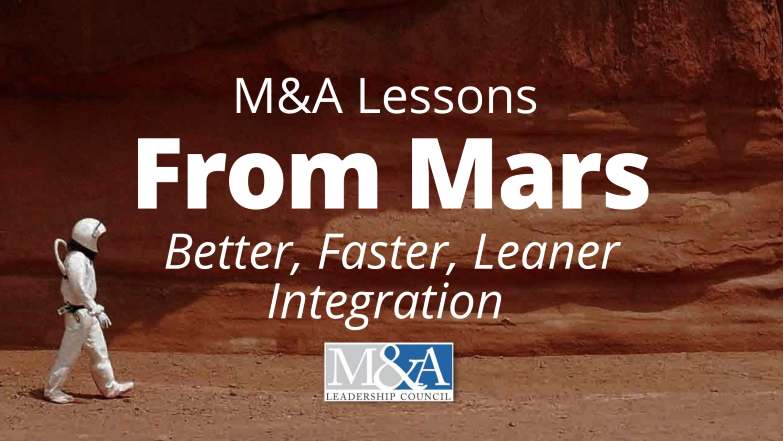M&A Lessons from Mars: Better, Faster, Leaner Integration
By Mark Herndon, Chairman, M&A Leadership Council
Some Intergalactic Guidance
Remember that 2015 movie with Matt Damon, called The Martian?
It should be “required watching” for all M&A professionals because it offers essential advice all M&A integrators should live by.
– Spoiler Alert –
Reflecting on his experience once back on earth, lead character Mark Watley gives a class of astronauts-in-training some priceless advice about what to do when confronted with an existential crisis:
“At some point, everything’s going to go south on you and you’re going to say, ‘this is it, this is how I end.’ Now you can either accept that, or you can get to work. You just begin. You do the math. You figure it out. You solve one problem, then the next one, then the next. If you solve enough problems, you get to come home.”
The 2023 M&A Integration Mandate
That advice resonated viscerally with me in 2022 as my client’s CEO demanded their highly experienced M&A team embrace an existential challenge to its survival.
“Either find a way to do integration 50% better, faster and leaner than we’ve ever done it before, or we’ll find a team that can!”
So, we started solving problems.
In fact, beginning in late 2021 and early 2022, we started hearing from many deeply experienced M&A Leadership Council alumni companies facing a similar mandate to get better, faster, leaner.
Our theory on why? Driven by the post-pandemic M&A boom with record-high deal volumes; combined with the more-urgent-than-ever need for strategically repositioning post-pandemic priorities, markets and solutions; and topped off with the worst-ever budget/resource squeeze in recent memory – dozens, perhaps hundreds of companies, were being challenged to rethink, refocus or reinvent how to “do M&A.”
Achieving M&A Speed-to-Value
We’re calling this mandate the need to achieve “M&A Speed-to-Value.” Theoretically speaking, solving the M&A speed-to-value problem for your company could involve dozens of components, with hundreds of potential solutions. But instead of colonizing Mars, we suggest you start with these crucial gaps that we routinely see over and over as the principal points of failure, and sometimes the cause of crash-landing the deal.
From Strategy Plan to Strategic Execution Processes
Let’s begin with the fundamental premise that M&A is an end-to-end business process for growth. Most acquirers by now have well developed M&A processes that guide their M&A leaders through the various phases, decisions, requirements, events, actions and phase-gates and from step to step through the “M&A lifecycle.” While these good approaches are widely viewed as an intact, coherent process, they rarely function as such. Most of them commonly devolve into a siloed collection of independent or loosely coupled actions more closely resembling a Rorschach test than a finely tuned ecosystem.
In sum, the brilliant strategic plan and target company (TargetCo) capabilities intended to uniquely fit that strategic need become progressively more blurry at every step and with every hand-off. This leads to the invariable disconnects between objectives and outcomes; between business case and actual synergy capture; and between the operating model that is needed for the combined entity to achieve its strategic and business case objectives and the actual operating model it is left with for years to come.
The results of such strategic atrophy are particularly damning in the following three sub-processes, which must purposefully and thoughtfully be connected from point-to-point and from turn-to-turn across the lifecycle as clearly and as directly as a GPS navigational system guides a traveler along an unknown superhighway.
1. Deal Strategy to Value-Driver Alignment:
To what extent does our deal strategy directly and explicitly identify the handful of most essential priority initiatives for actually achieving the overarching objectives?
To what extent are these value-driver initiatives directly and explicitly formulated into project teams specifically tasked, resourced and incentivized to achieve the most important of all business result outcomes of the deal?
To what extent does the Steering Committee, Corporate Development and the Board have visibility and input into these specific initiatives as isolated, elevated and reported above the swamp of 1,000-line milestone plans and burn-down charts that typically characterize the bulk of integration activities?
2. Business Case to Synergy Alignment:
Research and practical experience demonstrate that approximately 50% of all synergies aren’t identified until post-closing. Practical experience indicates that many deal business cases “don’t survive first impact with reality.”
So, let’s consider:
To what extent does your deal’s business sponsor, integration lead and related SME teams fully understand the assumptions and requirements of the deal’s business case?
To what extent are these assumptions — which are often made in a vacuum of confidential pre-deal analysis or executive committee discussions — vetted, validated and embraced by those that must drive their execution?
To what extent does your business case permit, even encourage, post-closing adjustments based on reality?
To what extent are you able to incentivize synergy performance beyond that which is captured in the financial model?
3. Operating Model Development and Execution:
Of these critically important strategic sub-processes, this one has our vote for the most universally misunderstood and most poorly managed.
There are typically as many different definitions of operating model as there are cooks in the kitchen. In essence, operating model refers to the way in which a company organizes its people, processes and technology to compete with its solutions. Gartner defines it well as “the blueprint for how value will be created and delivered to targeted customers.”
Yes, it is complex. But that’s no excuse for the level of abdication we typically see from senior leaders who are more inclined to kick this can down the road at the very moment dozens, if not hundreds, of work-stream leaders and SMEs are waiting for and most dependent on the assumptions, boundaries and parameters needed from the operating model to base their key recommendations and decisions on.
So, let’s consider:
To what extent do we include future state operating model as a part of our pre-pursuit corporate development analysis?
To what extent have we settled on what our internal definition of operating model should be and what our baseline future state model needs to look like?
To what extent do we include the right executives, leaders and SMEs to serve as an intact operating model “work-stream” accountable for identifying, fleshing out and validating the future state operating model for how the TargetCo fits into and provides value for our combined customers and what decisions or changes that will entail?
To what extent are these key planning inputs and assumptions provided for and aligned with key integration events and processes beginning at launch?
Process reengineering your internal M&A operations to achieve maximum speed-to-value should continue in a similar fashion and specifically address the known gaps, challenges, hotspots, or priority sub-processes that matter most. We’ll explore other common gaps to address in subsequent posts. By leveraging insights of key stakeholders along with identifying and adapting proven external best practices from other highly skilled acquirers, your team will then be in a much better position to rethink, refocus or reinvent how you do M&A to “get you home” with the desired results in hand.
—————————————————————–
We invite you to join us* for the ALL-NEW interactive in-person program we’ll present March 21-23, 2023 at the Manchester Grand Hyatt in San Diego, which will fully explore the concept of “M&A Speed-to-Value: Integration Done Better, Faster, Leaner.” Learn more here: The Art of M&A® for Integration Leaders: Collaborative Forum.
*It is recommended that registrants have attended at least one prior M&A course on integration and have completed at least one full prior integration. Not sure if this course is a fit for you? Let’s talk! Please contact: Mark Herndon ([email protected] or 866.394.3690)






